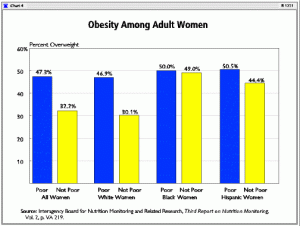It’s no longer news that the United States is nearing an obesity epidemic. But did you know that women are at a much greater risk than men for becoming overweight? In fact, according to a recent study by the US Centers for Disease Control and Prevention, women in the United States increased their caloric intake by 22% (and men by 7%) in the 30 years between 1971 and 2000.
Did you also know that women who have a lower socioeconomic status are 50 percent more likely to be obese than those women who belong to a higher income bracket? In many countries, especially developing countries, the trend is just opposite. Extra pounds are a sign of opulence, whereas thin figures are an indication of being poor. And this makes sense, right? If you don’t have money, you can’t put food on the table and your waistline inevitably shrinks.
In the U.S., where the picture is just the opposite, cheap food is not only readily available but it is also calorically-dense and nutritionally-void. A study in the American Journal of Clinical Nutrition suggested that snack foods like chips, packaged cakes, fast-food, boxes of mac & cheese, sodas and a host of other high-sugar, high-fat and inexpensive foods are appealing to those who are low-income because they are calorically-dense items. So when you’re on a super tight budget and food is scarce, eating foods that pack a strong calorie punch will go a lot further than say a salad with grilled chicken. And serving per serving, the less healthy foods cost far less.
Let’s not forgot either the comfort factor of food, particularly of these high fat and high sugar foods. Women, more than men, are more likely to turn to food to assuage feelings of depression, sadness, and anxiety. And usually women who seek solace in food reach for a box of Hostess cupcakes or a bowl of fettuccine alfredo, not a plate of poached chicken breast and steamed broccoli.
Financial matters are one of the primary factors in feeling stressed or tense. So when you put these two elements together, in addition to the low cost of unhealthy foods, it takes little guesswork in understanding why the obesity rates are so much higher for women who are in low socioeconomic income brackets.
Hopefully, as nutrition experts and public health leaders become more aware of this dynamic, interventions that target low income women can help to educate women on how they can provide healthy food to their family on a budget and how important it is to maintain a healthy body weight. In addition, all of us, from food manufactures to grocery store chains to citizens have to start promoting the access of affordable healthy food irrespective of socioeconomic status.
Blog Action Day is an annual event uniting bloggers from across the Web to discuss one very important topic. This year, the selected topic is poverty. DietsInReview.com is proud to be one of more than 11,000 blogs raising awareness.




fascinating post. didn’t think of that. :O
for my part, i turn to sites like freerice (rice donation), kiva (microfinance), and goodsearch (donation per search), as ways to help alleviate poverty online. i also put up their banners on my blog. 🙂
saw this post via the blog action day site. it’s great that you’re participating. 🙂
I always thought that being thin is linked to poverty but you prove me wrong and now I am agreeing with you. We should really join hands in order to lessen the threat against the poor. Let’s help them in the simplest method that we can think of.